MGMT646: ACNC Governance Standards Critique in NPO Governance
VerifiedAdded on 2023/06/03
|14
|3972
|413
Essay
AI Summary
This essay provides a detailed analysis of the ACNC Governance Standards for Australian charities and not-for-profit organizations. It examines the legal status of these standards, comparing them with the ASX Council for Corporate Governance principles and relevant corporate governance theories to assess their effectiveness. The essay delves into each of the five governance standards, highlighting their purpose and practical implications for charitable organizations. It also explores the alignment of these standards with ethical theories and principles of corporate governance, emphasizing their role in ensuring transparency, accountability, and public welfare within the Australian non-profit sector. The document concludes by reinforcing the significance of these standards in maintaining public trust and confidence in charitable organizations.
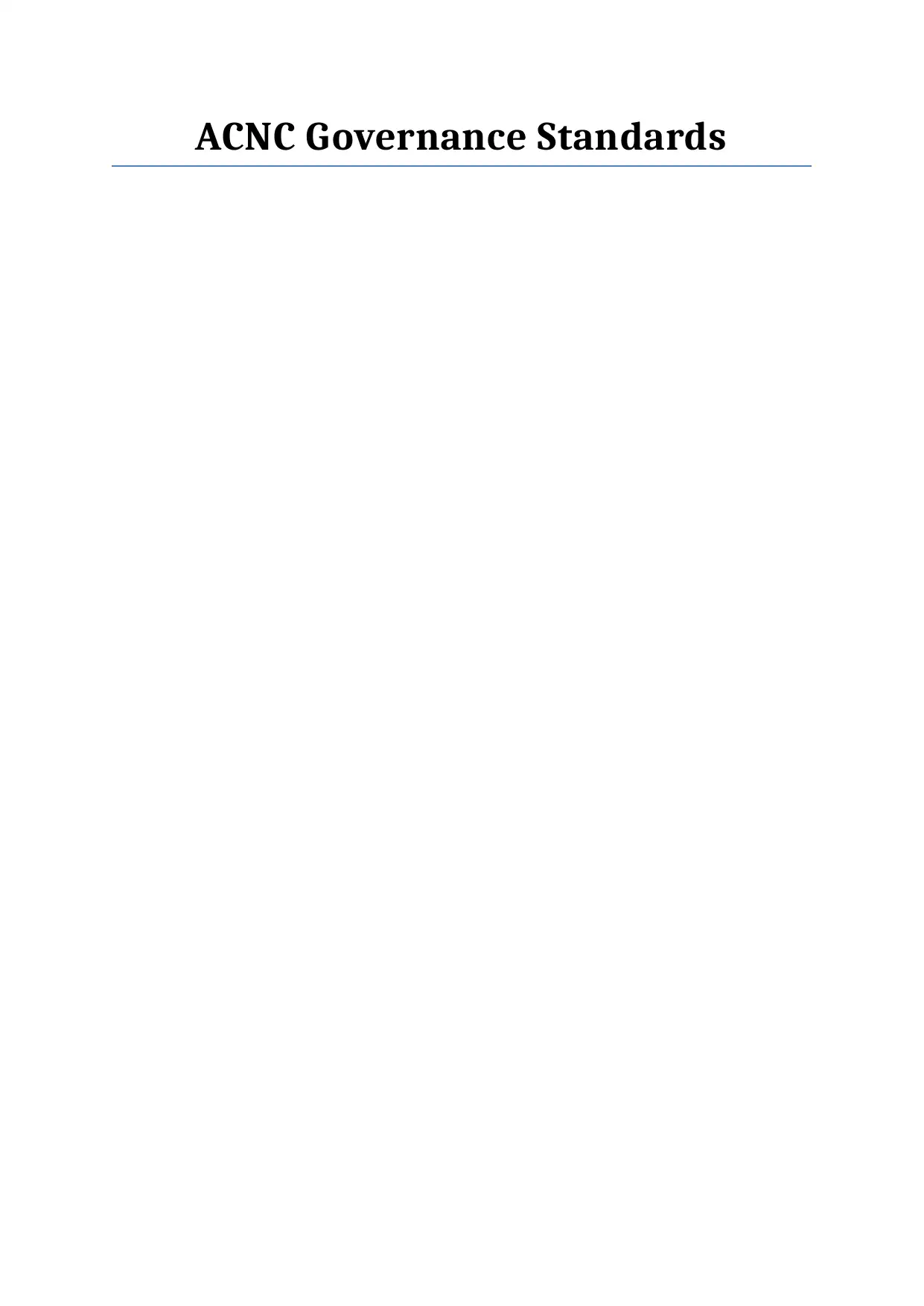
ACNC Governance Standards
Secure Best Marks with AI Grader
Need help grading? Try our AI Grader for instant feedback on your assignments.
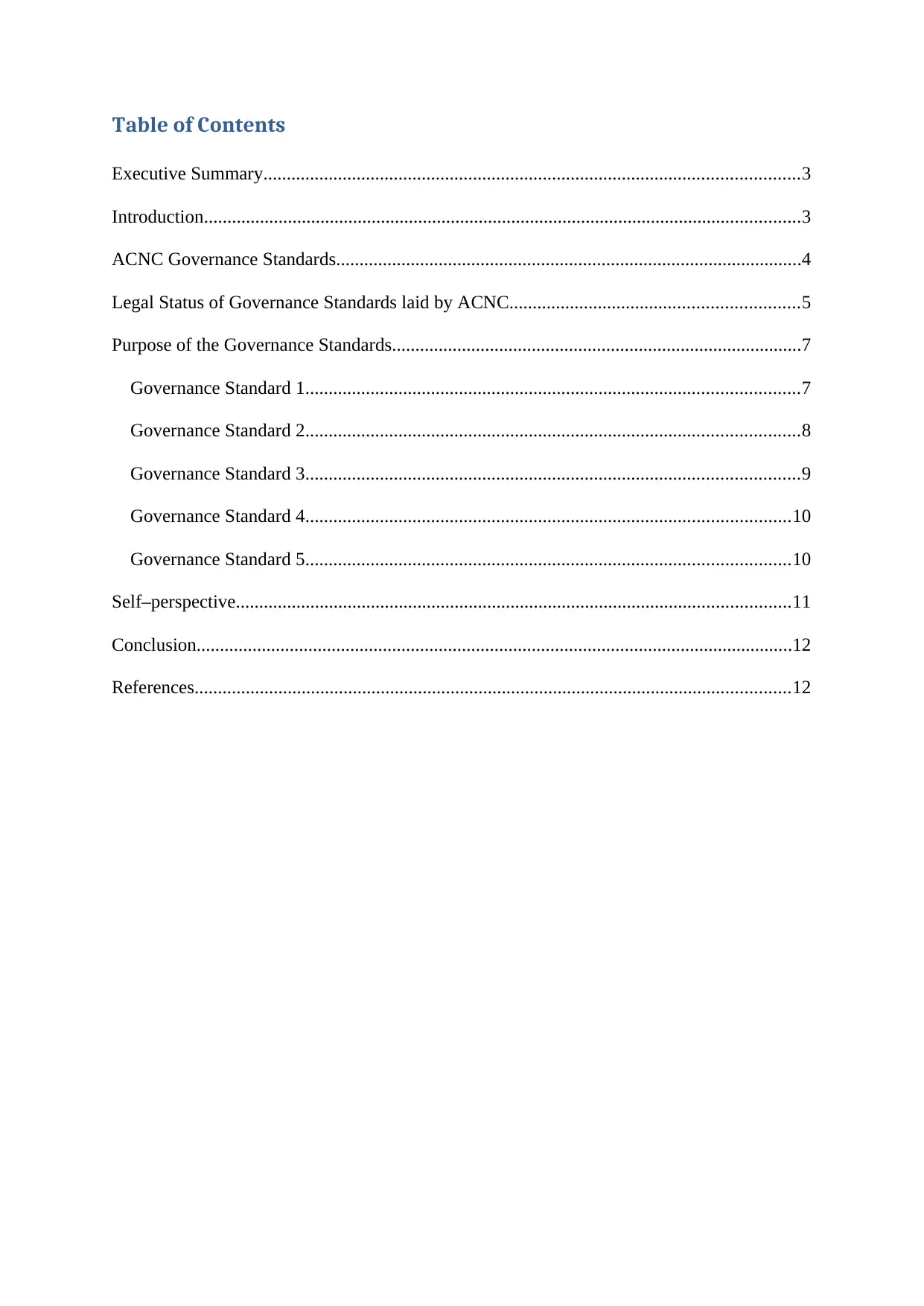
Table of Contents
Executive Summary...................................................................................................................3
Introduction................................................................................................................................3
ACNC Governance Standards....................................................................................................4
Legal Status of Governance Standards laid by ACNC..............................................................5
Purpose of the Governance Standards........................................................................................7
Governance Standard 1..........................................................................................................7
Governance Standard 2..........................................................................................................8
Governance Standard 3..........................................................................................................9
Governance Standard 4........................................................................................................10
Governance Standard 5........................................................................................................10
Self–perspective.......................................................................................................................11
Conclusion................................................................................................................................12
References................................................................................................................................12
Executive Summary...................................................................................................................3
Introduction................................................................................................................................3
ACNC Governance Standards....................................................................................................4
Legal Status of Governance Standards laid by ACNC..............................................................5
Purpose of the Governance Standards........................................................................................7
Governance Standard 1..........................................................................................................7
Governance Standard 2..........................................................................................................8
Governance Standard 3..........................................................................................................9
Governance Standard 4........................................................................................................10
Governance Standard 5........................................................................................................10
Self–perspective.......................................................................................................................11
Conclusion................................................................................................................................12
References................................................................................................................................12
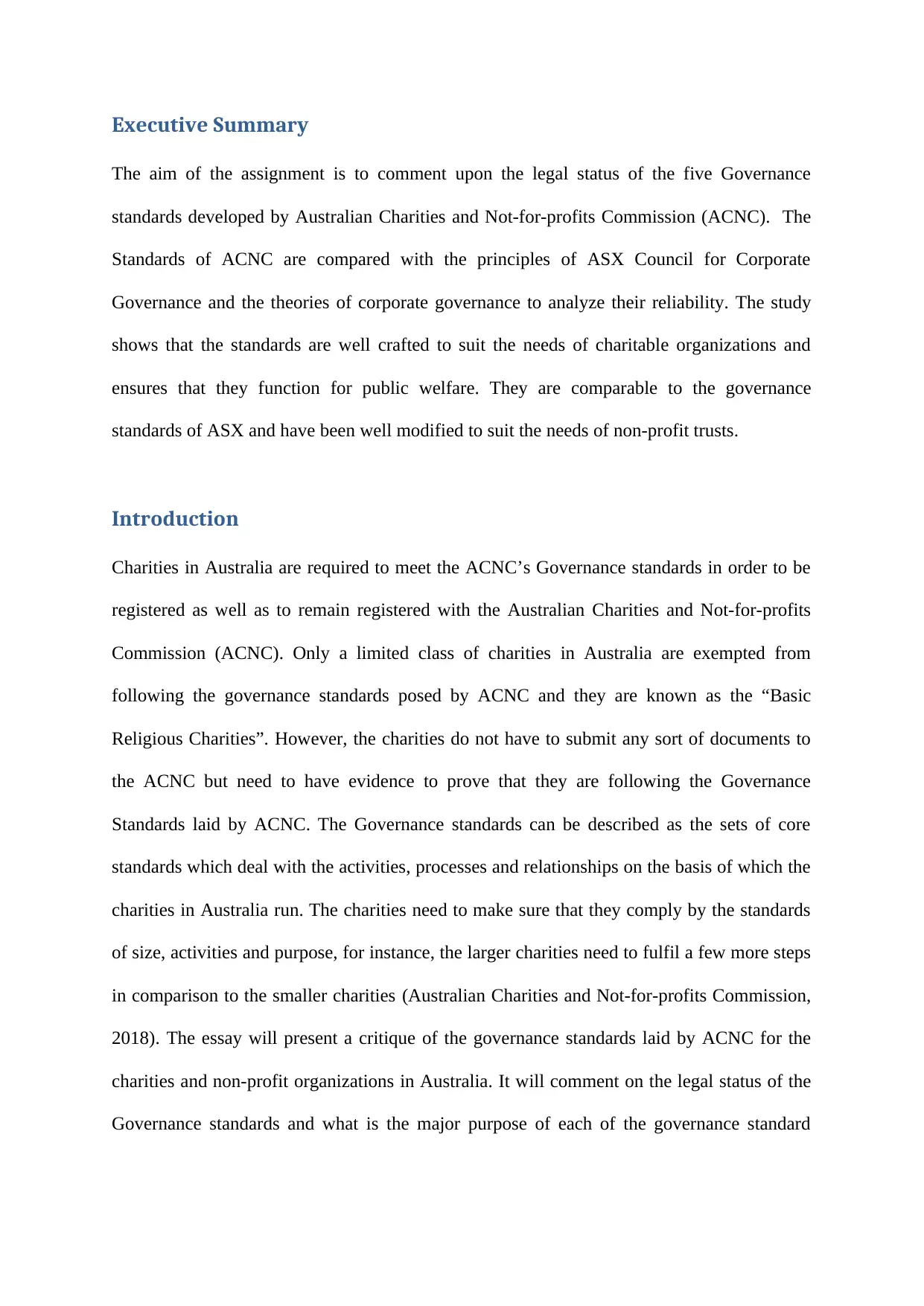
Executive Summary
The aim of the assignment is to comment upon the legal status of the five Governance
standards developed by Australian Charities and Not-for-profits Commission (ACNC). The
Standards of ACNC are compared with the principles of ASX Council for Corporate
Governance and the theories of corporate governance to analyze their reliability. The study
shows that the standards are well crafted to suit the needs of charitable organizations and
ensures that they function for public welfare. They are comparable to the governance
standards of ASX and have been well modified to suit the needs of non-profit trusts.
Introduction
Charities in Australia are required to meet the ACNC’s Governance standards in order to be
registered as well as to remain registered with the Australian Charities and Not-for-profits
Commission (ACNC). Only a limited class of charities in Australia are exempted from
following the governance standards posed by ACNC and they are known as the “Basic
Religious Charities”. However, the charities do not have to submit any sort of documents to
the ACNC but need to have evidence to prove that they are following the Governance
Standards laid by ACNC. The Governance standards can be described as the sets of core
standards which deal with the activities, processes and relationships on the basis of which the
charities in Australia run. The charities need to make sure that they comply by the standards
of size, activities and purpose, for instance, the larger charities need to fulfil a few more steps
in comparison to the smaller charities (Australian Charities and Not-for-profits Commission,
2018). The essay will present a critique of the governance standards laid by ACNC for the
charities and non-profit organizations in Australia. It will comment on the legal status of the
Governance standards and what is the major purpose of each of the governance standard
The aim of the assignment is to comment upon the legal status of the five Governance
standards developed by Australian Charities and Not-for-profits Commission (ACNC). The
Standards of ACNC are compared with the principles of ASX Council for Corporate
Governance and the theories of corporate governance to analyze their reliability. The study
shows that the standards are well crafted to suit the needs of charitable organizations and
ensures that they function for public welfare. They are comparable to the governance
standards of ASX and have been well modified to suit the needs of non-profit trusts.
Introduction
Charities in Australia are required to meet the ACNC’s Governance standards in order to be
registered as well as to remain registered with the Australian Charities and Not-for-profits
Commission (ACNC). Only a limited class of charities in Australia are exempted from
following the governance standards posed by ACNC and they are known as the “Basic
Religious Charities”. However, the charities do not have to submit any sort of documents to
the ACNC but need to have evidence to prove that they are following the Governance
Standards laid by ACNC. The Governance standards can be described as the sets of core
standards which deal with the activities, processes and relationships on the basis of which the
charities in Australia run. The charities need to make sure that they comply by the standards
of size, activities and purpose, for instance, the larger charities need to fulfil a few more steps
in comparison to the smaller charities (Australian Charities and Not-for-profits Commission,
2018). The essay will present a critique of the governance standards laid by ACNC for the
charities and non-profit organizations in Australia. It will comment on the legal status of the
Governance standards and what is the major purpose of each of the governance standard
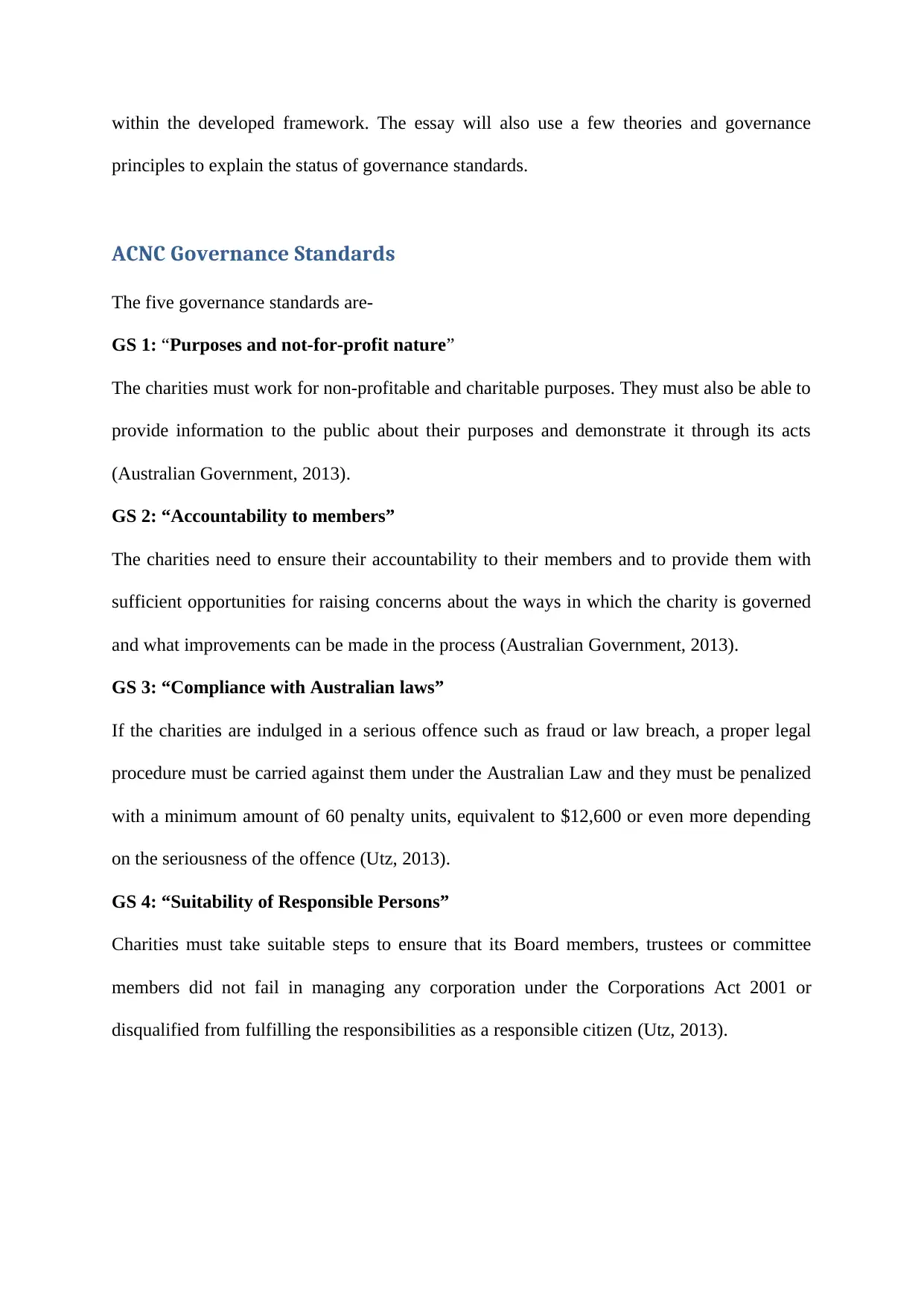
within the developed framework. The essay will also use a few theories and governance
principles to explain the status of governance standards.
ACNC Governance Standards
The five governance standards are-
GS 1: “Purposes and not-for-profit nature”
The charities must work for non-profitable and charitable purposes. They must also be able to
provide information to the public about their purposes and demonstrate it through its acts
(Australian Government, 2013).
GS 2: “Accountability to members”
The charities need to ensure their accountability to their members and to provide them with
sufficient opportunities for raising concerns about the ways in which the charity is governed
and what improvements can be made in the process (Australian Government, 2013).
GS 3: “Compliance with Australian laws”
If the charities are indulged in a serious offence such as fraud or law breach, a proper legal
procedure must be carried against them under the Australian Law and they must be penalized
with a minimum amount of 60 penalty units, equivalent to $12,600 or even more depending
on the seriousness of the offence (Utz, 2013).
GS 4: “Suitability of Responsible Persons”
Charities must take suitable steps to ensure that its Board members, trustees or committee
members did not fail in managing any corporation under the Corporations Act 2001 or
disqualified from fulfilling the responsibilities as a responsible citizen (Utz, 2013).
principles to explain the status of governance standards.
ACNC Governance Standards
The five governance standards are-
GS 1: “Purposes and not-for-profit nature”
The charities must work for non-profitable and charitable purposes. They must also be able to
provide information to the public about their purposes and demonstrate it through its acts
(Australian Government, 2013).
GS 2: “Accountability to members”
The charities need to ensure their accountability to their members and to provide them with
sufficient opportunities for raising concerns about the ways in which the charity is governed
and what improvements can be made in the process (Australian Government, 2013).
GS 3: “Compliance with Australian laws”
If the charities are indulged in a serious offence such as fraud or law breach, a proper legal
procedure must be carried against them under the Australian Law and they must be penalized
with a minimum amount of 60 penalty units, equivalent to $12,600 or even more depending
on the seriousness of the offence (Utz, 2013).
GS 4: “Suitability of Responsible Persons”
Charities must take suitable steps to ensure that its Board members, trustees or committee
members did not fail in managing any corporation under the Corporations Act 2001 or
disqualified from fulfilling the responsibilities as a responsible citizen (Utz, 2013).
Secure Best Marks with AI Grader
Need help grading? Try our AI Grader for instant feedback on your assignments.

GS 5: “Duties of Responsible Persons”
The Charities need to take measurable steps to ensure that the Responsible people of the
charity understand and carry out all the duties as mentioned in GS 5 (Ramsay & Webster,
2017).
Legal Status of Governance Standards laid by ACNC
The unexpected changes in the corporate governance have always been a topic of debate in
the business circle of Australia. It is also associated with the judicial interpretation. The
Australian Charities and Not-for-profits Commission Act 2013 (Cth) was amended by the
Australian Government on 1st July, 2013 and the Australian Charities and Not-for-profits
Commission Amendment Regulation 2013 (No. 1) (Cth) (Regulations) came into force. One
of the major effects of the Regulations as mentioned in the amended version was to insert the
Division 45, i.e., the governance standards into the Regulations, which came to be known as
the “Governance Standards”. All the charities in Australia are bound to abide by the 5
Governance standards in order to remain functioning. The ACNC is authorised by the
Australian Government to regulate the charities and non-profit organizations in the country as
per the Australian Charities and Not-for-profits Commission Act 2012 (Cth) (Law Institute of
Victoria, 2018)
In a simplified manner, it can be stated under section 45.1 of the Regulations that the
governance standards support the registered charities and non-profit organizations in
Australia to fulfil their objectives by providing the least level of assurance that they will meet
the expectations of the community in terms of how a registered entity needs to be managed”
(Dundas Lawyers , 2013).
The ACNC aims at expanding the ACNC Act provisions through these Governance standards
to improve the accountability of non-profit entities to the beneficiaries, donors and the public.
The Charities need to take measurable steps to ensure that the Responsible people of the
charity understand and carry out all the duties as mentioned in GS 5 (Ramsay & Webster,
2017).
Legal Status of Governance Standards laid by ACNC
The unexpected changes in the corporate governance have always been a topic of debate in
the business circle of Australia. It is also associated with the judicial interpretation. The
Australian Charities and Not-for-profits Commission Act 2013 (Cth) was amended by the
Australian Government on 1st July, 2013 and the Australian Charities and Not-for-profits
Commission Amendment Regulation 2013 (No. 1) (Cth) (Regulations) came into force. One
of the major effects of the Regulations as mentioned in the amended version was to insert the
Division 45, i.e., the governance standards into the Regulations, which came to be known as
the “Governance Standards”. All the charities in Australia are bound to abide by the 5
Governance standards in order to remain functioning. The ACNC is authorised by the
Australian Government to regulate the charities and non-profit organizations in the country as
per the Australian Charities and Not-for-profits Commission Act 2012 (Cth) (Law Institute of
Victoria, 2018)
In a simplified manner, it can be stated under section 45.1 of the Regulations that the
governance standards support the registered charities and non-profit organizations in
Australia to fulfil their objectives by providing the least level of assurance that they will meet
the expectations of the community in terms of how a registered entity needs to be managed”
(Dundas Lawyers , 2013).
The ACNC aims at expanding the ACNC Act provisions through these Governance standards
to improve the accountability of non-profit entities to the beneficiaries, donors and the public.
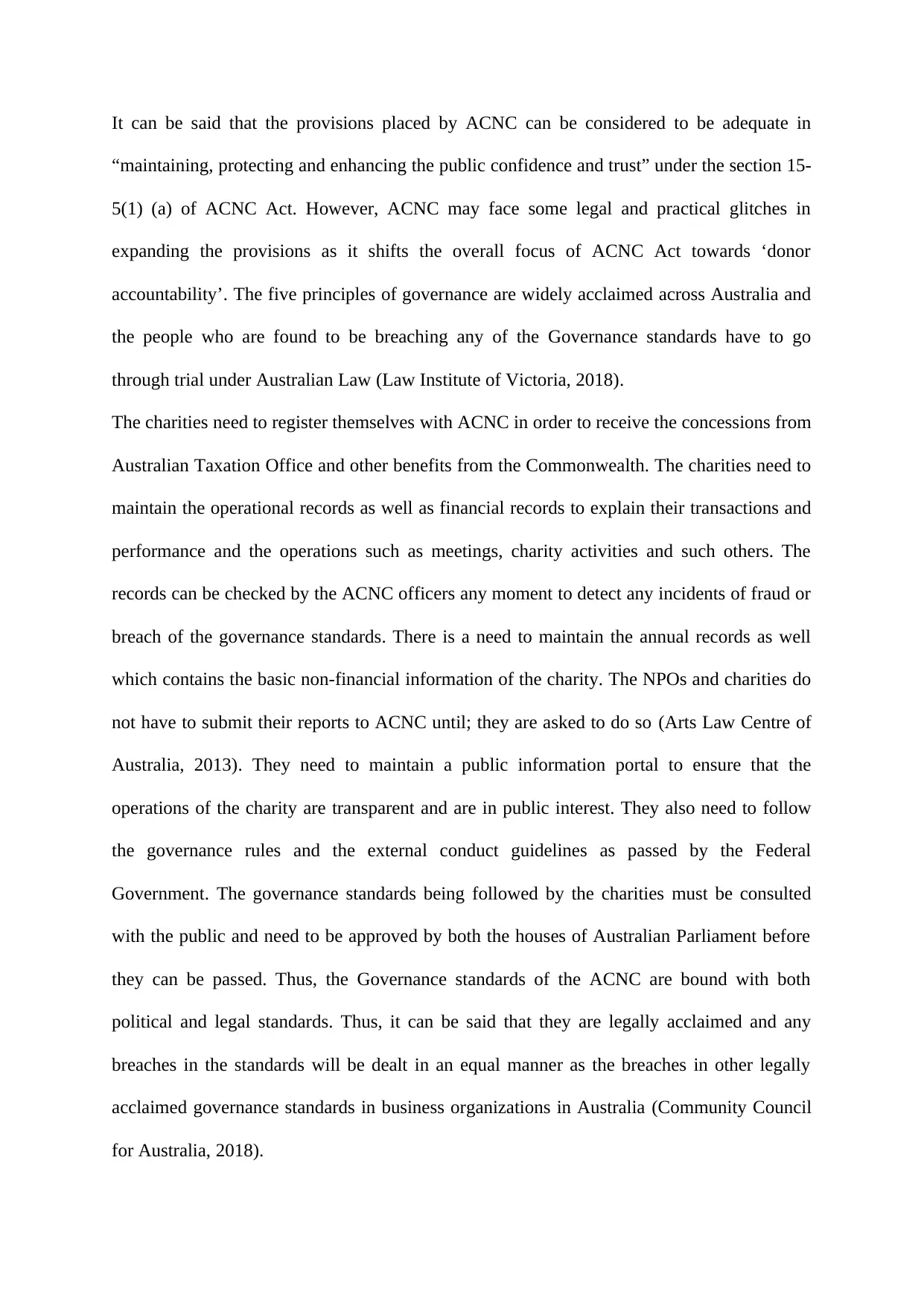
It can be said that the provisions placed by ACNC can be considered to be adequate in
“maintaining, protecting and enhancing the public confidence and trust” under the section 15-
5(1) (a) of ACNC Act. However, ACNC may face some legal and practical glitches in
expanding the provisions as it shifts the overall focus of ACNC Act towards ‘donor
accountability’. The five principles of governance are widely acclaimed across Australia and
the people who are found to be breaching any of the Governance standards have to go
through trial under Australian Law (Law Institute of Victoria, 2018).
The charities need to register themselves with ACNC in order to receive the concessions from
Australian Taxation Office and other benefits from the Commonwealth. The charities need to
maintain the operational records as well as financial records to explain their transactions and
performance and the operations such as meetings, charity activities and such others. The
records can be checked by the ACNC officers any moment to detect any incidents of fraud or
breach of the governance standards. There is a need to maintain the annual records as well
which contains the basic non-financial information of the charity. The NPOs and charities do
not have to submit their reports to ACNC until; they are asked to do so (Arts Law Centre of
Australia, 2013). They need to maintain a public information portal to ensure that the
operations of the charity are transparent and are in public interest. They also need to follow
the governance rules and the external conduct guidelines as passed by the Federal
Government. The governance standards being followed by the charities must be consulted
with the public and need to be approved by both the houses of Australian Parliament before
they can be passed. Thus, the Governance standards of the ACNC are bound with both
political and legal standards. Thus, it can be said that they are legally acclaimed and any
breaches in the standards will be dealt in an equal manner as the breaches in other legally
acclaimed governance standards in business organizations in Australia (Community Council
for Australia, 2018).
“maintaining, protecting and enhancing the public confidence and trust” under the section 15-
5(1) (a) of ACNC Act. However, ACNC may face some legal and practical glitches in
expanding the provisions as it shifts the overall focus of ACNC Act towards ‘donor
accountability’. The five principles of governance are widely acclaimed across Australia and
the people who are found to be breaching any of the Governance standards have to go
through trial under Australian Law (Law Institute of Victoria, 2018).
The charities need to register themselves with ACNC in order to receive the concessions from
Australian Taxation Office and other benefits from the Commonwealth. The charities need to
maintain the operational records as well as financial records to explain their transactions and
performance and the operations such as meetings, charity activities and such others. The
records can be checked by the ACNC officers any moment to detect any incidents of fraud or
breach of the governance standards. There is a need to maintain the annual records as well
which contains the basic non-financial information of the charity. The NPOs and charities do
not have to submit their reports to ACNC until; they are asked to do so (Arts Law Centre of
Australia, 2013). They need to maintain a public information portal to ensure that the
operations of the charity are transparent and are in public interest. They also need to follow
the governance rules and the external conduct guidelines as passed by the Federal
Government. The governance standards being followed by the charities must be consulted
with the public and need to be approved by both the houses of Australian Parliament before
they can be passed. Thus, the Governance standards of the ACNC are bound with both
political and legal standards. Thus, it can be said that they are legally acclaimed and any
breaches in the standards will be dealt in an equal manner as the breaches in other legally
acclaimed governance standards in business organizations in Australia (Community Council
for Australia, 2018).
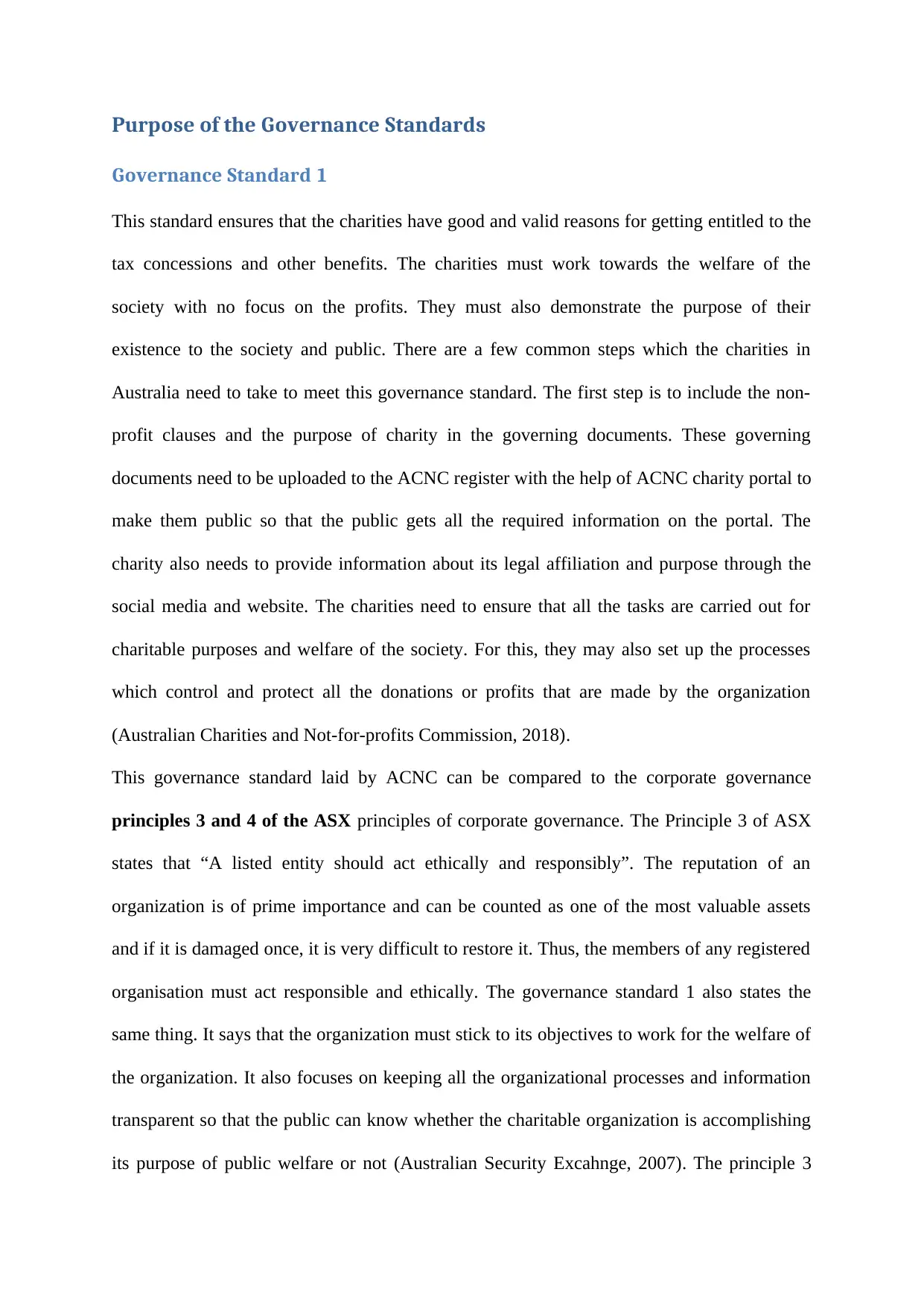
Purpose of the Governance Standards
Governance Standard 1
This standard ensures that the charities have good and valid reasons for getting entitled to the
tax concessions and other benefits. The charities must work towards the welfare of the
society with no focus on the profits. They must also demonstrate the purpose of their
existence to the society and public. There are a few common steps which the charities in
Australia need to take to meet this governance standard. The first step is to include the non-
profit clauses and the purpose of charity in the governing documents. These governing
documents need to be uploaded to the ACNC register with the help of ACNC charity portal to
make them public so that the public gets all the required information on the portal. The
charity also needs to provide information about its legal affiliation and purpose through the
social media and website. The charities need to ensure that all the tasks are carried out for
charitable purposes and welfare of the society. For this, they may also set up the processes
which control and protect all the donations or profits that are made by the organization
(Australian Charities and Not-for-profits Commission, 2018).
This governance standard laid by ACNC can be compared to the corporate governance
principles 3 and 4 of the ASX principles of corporate governance. The Principle 3 of ASX
states that “A listed entity should act ethically and responsibly”. The reputation of an
organization is of prime importance and can be counted as one of the most valuable assets
and if it is damaged once, it is very difficult to restore it. Thus, the members of any registered
organisation must act responsible and ethically. The governance standard 1 also states the
same thing. It says that the organization must stick to its objectives to work for the welfare of
the organization. It also focuses on keeping all the organizational processes and information
transparent so that the public can know whether the charitable organization is accomplishing
its purpose of public welfare or not (Australian Security Excahnge, 2007). The principle 3
Governance Standard 1
This standard ensures that the charities have good and valid reasons for getting entitled to the
tax concessions and other benefits. The charities must work towards the welfare of the
society with no focus on the profits. They must also demonstrate the purpose of their
existence to the society and public. There are a few common steps which the charities in
Australia need to take to meet this governance standard. The first step is to include the non-
profit clauses and the purpose of charity in the governing documents. These governing
documents need to be uploaded to the ACNC register with the help of ACNC charity portal to
make them public so that the public gets all the required information on the portal. The
charity also needs to provide information about its legal affiliation and purpose through the
social media and website. The charities need to ensure that all the tasks are carried out for
charitable purposes and welfare of the society. For this, they may also set up the processes
which control and protect all the donations or profits that are made by the organization
(Australian Charities and Not-for-profits Commission, 2018).
This governance standard laid by ACNC can be compared to the corporate governance
principles 3 and 4 of the ASX principles of corporate governance. The Principle 3 of ASX
states that “A listed entity should act ethically and responsibly”. The reputation of an
organization is of prime importance and can be counted as one of the most valuable assets
and if it is damaged once, it is very difficult to restore it. Thus, the members of any registered
organisation must act responsible and ethically. The governance standard 1 also states the
same thing. It says that the organization must stick to its objectives to work for the welfare of
the organization. It also focuses on keeping all the organizational processes and information
transparent so that the public can know whether the charitable organization is accomplishing
its purpose of public welfare or not (Australian Security Excahnge, 2007). The principle 3
Paraphrase This Document
Need a fresh take? Get an instant paraphrase of this document with our AI Paraphraser
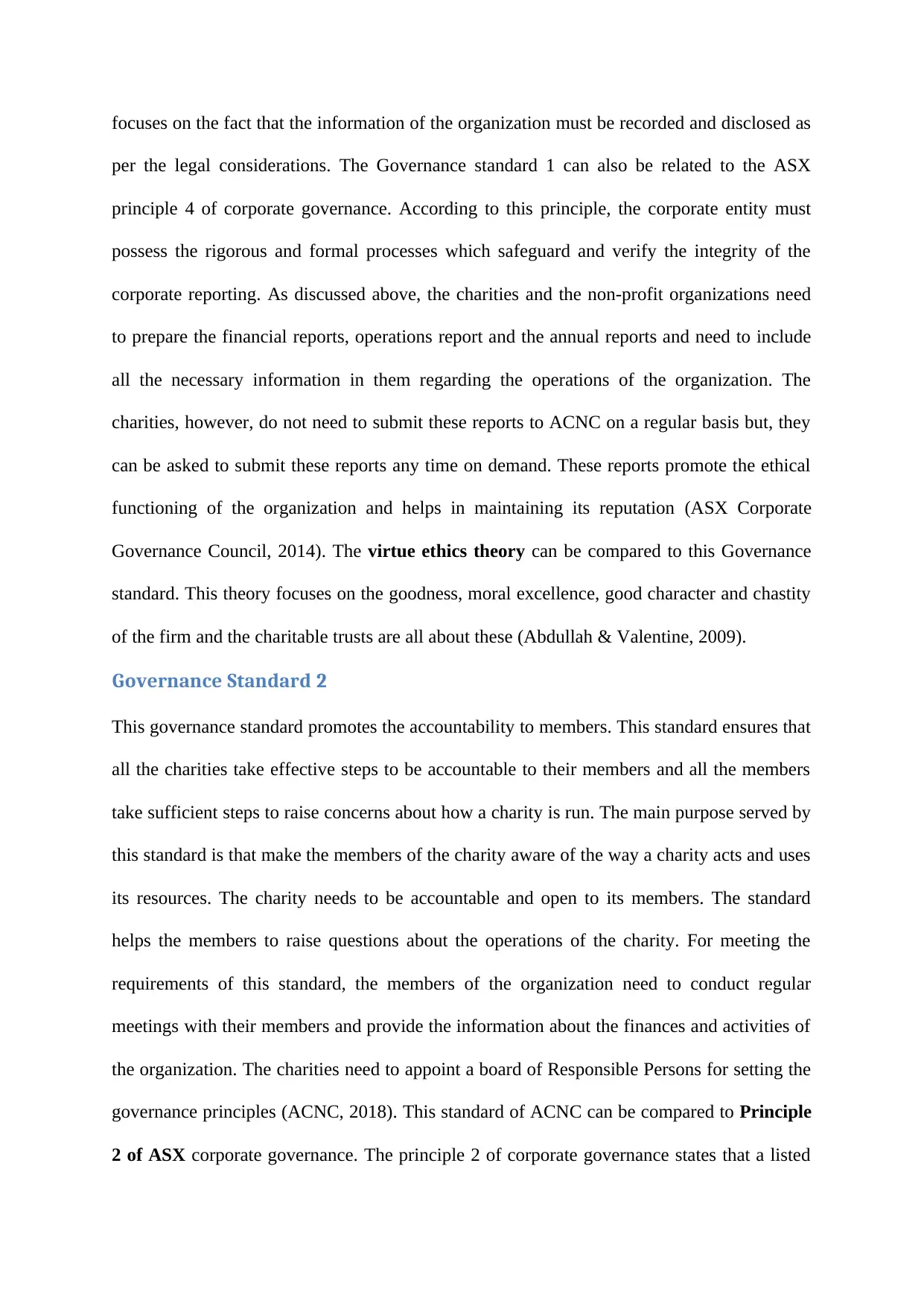
focuses on the fact that the information of the organization must be recorded and disclosed as
per the legal considerations. The Governance standard 1 can also be related to the ASX
principle 4 of corporate governance. According to this principle, the corporate entity must
possess the rigorous and formal processes which safeguard and verify the integrity of the
corporate reporting. As discussed above, the charities and the non-profit organizations need
to prepare the financial reports, operations report and the annual reports and need to include
all the necessary information in them regarding the operations of the organization. The
charities, however, do not need to submit these reports to ACNC on a regular basis but, they
can be asked to submit these reports any time on demand. These reports promote the ethical
functioning of the organization and helps in maintaining its reputation (ASX Corporate
Governance Council, 2014). The virtue ethics theory can be compared to this Governance
standard. This theory focuses on the goodness, moral excellence, good character and chastity
of the firm and the charitable trusts are all about these (Abdullah & Valentine, 2009).
Governance Standard 2
This governance standard promotes the accountability to members. This standard ensures that
all the charities take effective steps to be accountable to their members and all the members
take sufficient steps to raise concerns about how a charity is run. The main purpose served by
this standard is that make the members of the charity aware of the way a charity acts and uses
its resources. The charity needs to be accountable and open to its members. The standard
helps the members to raise questions about the operations of the charity. For meeting the
requirements of this standard, the members of the organization need to conduct regular
meetings with their members and provide the information about the finances and activities of
the organization. The charities need to appoint a board of Responsible Persons for setting the
governance principles (ACNC, 2018). This standard of ACNC can be compared to Principle
2 of ASX corporate governance. The principle 2 of corporate governance states that a listed
per the legal considerations. The Governance standard 1 can also be related to the ASX
principle 4 of corporate governance. According to this principle, the corporate entity must
possess the rigorous and formal processes which safeguard and verify the integrity of the
corporate reporting. As discussed above, the charities and the non-profit organizations need
to prepare the financial reports, operations report and the annual reports and need to include
all the necessary information in them regarding the operations of the organization. The
charities, however, do not need to submit these reports to ACNC on a regular basis but, they
can be asked to submit these reports any time on demand. These reports promote the ethical
functioning of the organization and helps in maintaining its reputation (ASX Corporate
Governance Council, 2014). The virtue ethics theory can be compared to this Governance
standard. This theory focuses on the goodness, moral excellence, good character and chastity
of the firm and the charitable trusts are all about these (Abdullah & Valentine, 2009).
Governance Standard 2
This governance standard promotes the accountability to members. This standard ensures that
all the charities take effective steps to be accountable to their members and all the members
take sufficient steps to raise concerns about how a charity is run. The main purpose served by
this standard is that make the members of the charity aware of the way a charity acts and uses
its resources. The charity needs to be accountable and open to its members. The standard
helps the members to raise questions about the operations of the charity. For meeting the
requirements of this standard, the members of the organization need to conduct regular
meetings with their members and provide the information about the finances and activities of
the organization. The charities need to appoint a board of Responsible Persons for setting the
governance principles (ACNC, 2018). This standard of ACNC can be compared to Principle
2 of ASX corporate governance. The principle 2 of corporate governance states that a listed
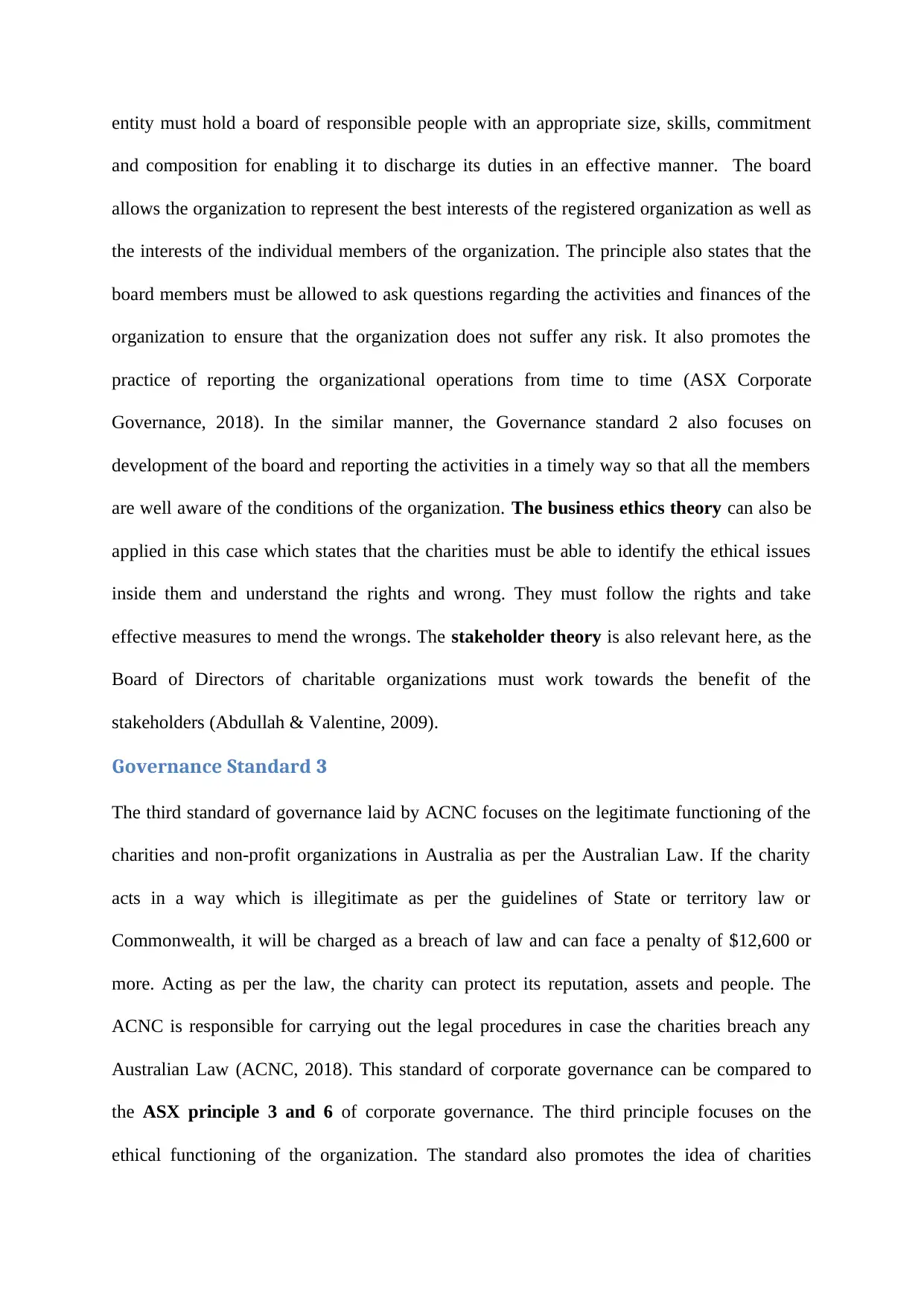
entity must hold a board of responsible people with an appropriate size, skills, commitment
and composition for enabling it to discharge its duties in an effective manner. The board
allows the organization to represent the best interests of the registered organization as well as
the interests of the individual members of the organization. The principle also states that the
board members must be allowed to ask questions regarding the activities and finances of the
organization to ensure that the organization does not suffer any risk. It also promotes the
practice of reporting the organizational operations from time to time (ASX Corporate
Governance, 2018). In the similar manner, the Governance standard 2 also focuses on
development of the board and reporting the activities in a timely way so that all the members
are well aware of the conditions of the organization. The business ethics theory can also be
applied in this case which states that the charities must be able to identify the ethical issues
inside them and understand the rights and wrong. They must follow the rights and take
effective measures to mend the wrongs. The stakeholder theory is also relevant here, as the
Board of Directors of charitable organizations must work towards the benefit of the
stakeholders (Abdullah & Valentine, 2009).
Governance Standard 3
The third standard of governance laid by ACNC focuses on the legitimate functioning of the
charities and non-profit organizations in Australia as per the Australian Law. If the charity
acts in a way which is illegitimate as per the guidelines of State or territory law or
Commonwealth, it will be charged as a breach of law and can face a penalty of $12,600 or
more. Acting as per the law, the charity can protect its reputation, assets and people. The
ACNC is responsible for carrying out the legal procedures in case the charities breach any
Australian Law (ACNC, 2018). This standard of corporate governance can be compared to
the ASX principle 3 and 6 of corporate governance. The third principle focuses on the
ethical functioning of the organization. The standard also promotes the idea of charities
and composition for enabling it to discharge its duties in an effective manner. The board
allows the organization to represent the best interests of the registered organization as well as
the interests of the individual members of the organization. The principle also states that the
board members must be allowed to ask questions regarding the activities and finances of the
organization to ensure that the organization does not suffer any risk. It also promotes the
practice of reporting the organizational operations from time to time (ASX Corporate
Governance, 2018). In the similar manner, the Governance standard 2 also focuses on
development of the board and reporting the activities in a timely way so that all the members
are well aware of the conditions of the organization. The business ethics theory can also be
applied in this case which states that the charities must be able to identify the ethical issues
inside them and understand the rights and wrong. They must follow the rights and take
effective measures to mend the wrongs. The stakeholder theory is also relevant here, as the
Board of Directors of charitable organizations must work towards the benefit of the
stakeholders (Abdullah & Valentine, 2009).
Governance Standard 3
The third standard of governance laid by ACNC focuses on the legitimate functioning of the
charities and non-profit organizations in Australia as per the Australian Law. If the charity
acts in a way which is illegitimate as per the guidelines of State or territory law or
Commonwealth, it will be charged as a breach of law and can face a penalty of $12,600 or
more. Acting as per the law, the charity can protect its reputation, assets and people. The
ACNC is responsible for carrying out the legal procedures in case the charities breach any
Australian Law (ACNC, 2018). This standard of corporate governance can be compared to
the ASX principle 3 and 6 of corporate governance. The third principle focuses on the
ethical functioning of the organization. The standard also promotes the idea of charities
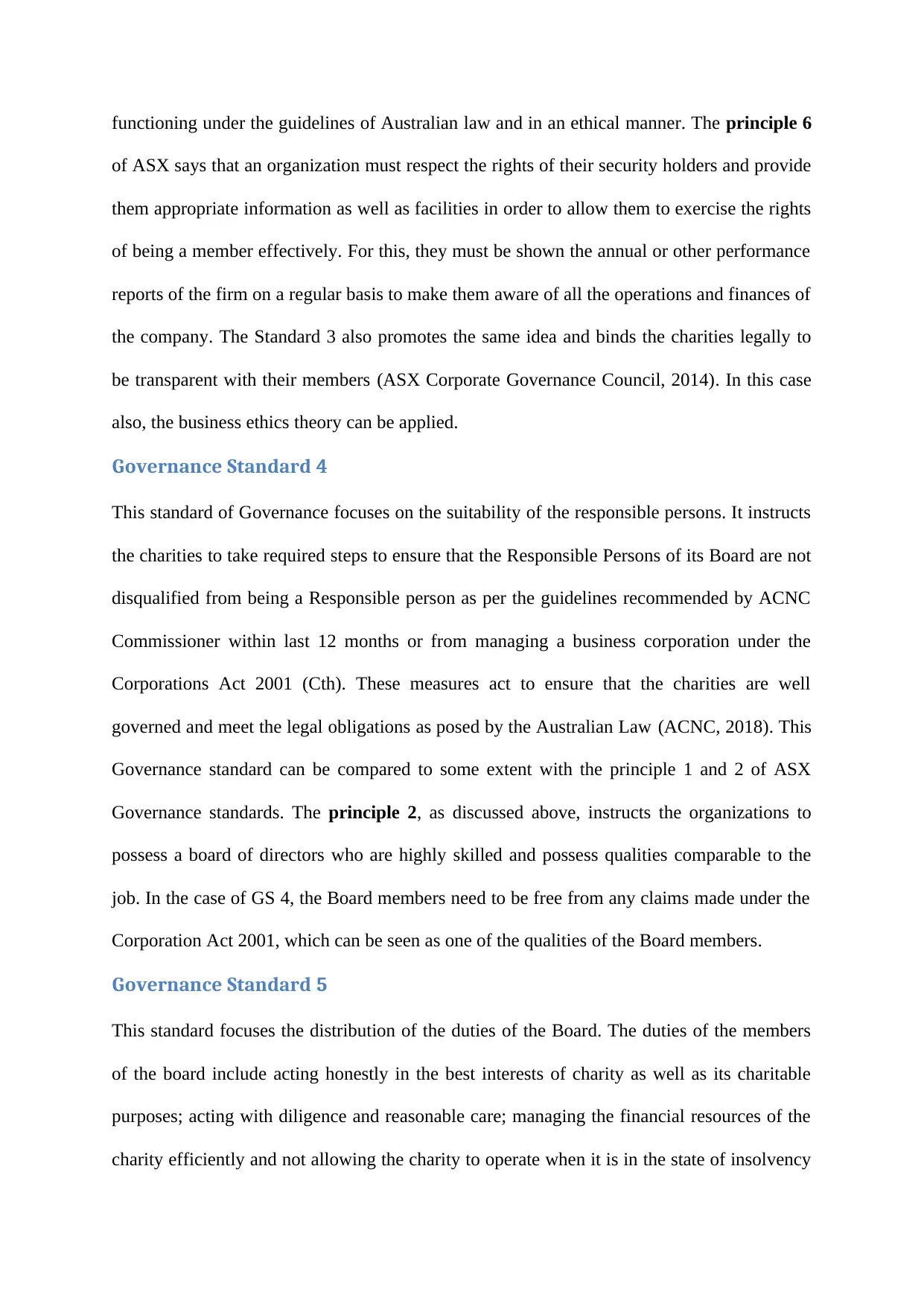
functioning under the guidelines of Australian law and in an ethical manner. The principle 6
of ASX says that an organization must respect the rights of their security holders and provide
them appropriate information as well as facilities in order to allow them to exercise the rights
of being a member effectively. For this, they must be shown the annual or other performance
reports of the firm on a regular basis to make them aware of all the operations and finances of
the company. The Standard 3 also promotes the same idea and binds the charities legally to
be transparent with their members (ASX Corporate Governance Council, 2014). In this case
also, the business ethics theory can be applied.
Governance Standard 4
This standard of Governance focuses on the suitability of the responsible persons. It instructs
the charities to take required steps to ensure that the Responsible Persons of its Board are not
disqualified from being a Responsible person as per the guidelines recommended by ACNC
Commissioner within last 12 months or from managing a business corporation under the
Corporations Act 2001 (Cth). These measures act to ensure that the charities are well
governed and meet the legal obligations as posed by the Australian Law (ACNC, 2018). This
Governance standard can be compared to some extent with the principle 1 and 2 of ASX
Governance standards. The principle 2, as discussed above, instructs the organizations to
possess a board of directors who are highly skilled and possess qualities comparable to the
job. In the case of GS 4, the Board members need to be free from any claims made under the
Corporation Act 2001, which can be seen as one of the qualities of the Board members.
Governance Standard 5
This standard focuses the distribution of the duties of the Board. The duties of the members
of the board include acting honestly in the best interests of charity as well as its charitable
purposes; acting with diligence and reasonable care; managing the financial resources of the
charity efficiently and not allowing the charity to operate when it is in the state of insolvency
of ASX says that an organization must respect the rights of their security holders and provide
them appropriate information as well as facilities in order to allow them to exercise the rights
of being a member effectively. For this, they must be shown the annual or other performance
reports of the firm on a regular basis to make them aware of all the operations and finances of
the company. The Standard 3 also promotes the same idea and binds the charities legally to
be transparent with their members (ASX Corporate Governance Council, 2014). In this case
also, the business ethics theory can be applied.
Governance Standard 4
This standard of Governance focuses on the suitability of the responsible persons. It instructs
the charities to take required steps to ensure that the Responsible Persons of its Board are not
disqualified from being a Responsible person as per the guidelines recommended by ACNC
Commissioner within last 12 months or from managing a business corporation under the
Corporations Act 2001 (Cth). These measures act to ensure that the charities are well
governed and meet the legal obligations as posed by the Australian Law (ACNC, 2018). This
Governance standard can be compared to some extent with the principle 1 and 2 of ASX
Governance standards. The principle 2, as discussed above, instructs the organizations to
possess a board of directors who are highly skilled and possess qualities comparable to the
job. In the case of GS 4, the Board members need to be free from any claims made under the
Corporation Act 2001, which can be seen as one of the qualities of the Board members.
Governance Standard 5
This standard focuses the distribution of the duties of the Board. The duties of the members
of the board include acting honestly in the best interests of charity as well as its charitable
purposes; acting with diligence and reasonable care; managing the financial resources of the
charity efficiently and not allowing the charity to operate when it is in the state of insolvency
Secure Best Marks with AI Grader
Need help grading? Try our AI Grader for instant feedback on your assignments.

as per Corporations Act 2001. The roles of the Responsible Persons must be distributed in a
way that they satisfy the above duties. This Governance standard can be compared to
Principle 1 of ASX Corporate Governance Principles. The Principle 1 allows the
organizations to choose a management or board which meets all the requirements and is as
per the obligations made under the Australian Law. It says that the roles and responsibilities
of the Board must be distributed effectively and need to be monitored on a timely basis (ASX
Corporate Governance, 2018). However, the process of monitoring their role has not been
mentioned elaborative in Governance standard 5.
This Governance standard can also be related to the stewardship theory of corporate
governance. This theory promotes the idea that the Board of responsible persons in the
organization must work towards the welfare of the entire organization, not just for fulfilling
their personal interests. Here also, it can be seen that the ACNC binds the Board of the
charities to work for the accomplishment of the charitable purposes of the organization
(Chambers et al., 2013).
Self–perspective
In my opinion, all the governance standards laid by the ACNC are suitable for maintaining
the perfect functioning of the charitable trusts and non-profit organizations. All the corporate
governance standards highlighted by them are comparable to the corporate governance codes
laid by ASX Corporate Governance Council, which is considered to be the prime
organization for managing the duties and activities of the Board of Directors (ASX Limited ,
2018). The best part I found about the governance standards laid by ACNC is that they have
been modified to suit the needs of the non-profit organizations. They have included only the
principles considering the ethical behaviour and practices and the responsibilities of the
Board to ensure that welfare is being done for the people in need (Community Council for
way that they satisfy the above duties. This Governance standard can be compared to
Principle 1 of ASX Corporate Governance Principles. The Principle 1 allows the
organizations to choose a management or board which meets all the requirements and is as
per the obligations made under the Australian Law. It says that the roles and responsibilities
of the Board must be distributed effectively and need to be monitored on a timely basis (ASX
Corporate Governance, 2018). However, the process of monitoring their role has not been
mentioned elaborative in Governance standard 5.
This Governance standard can also be related to the stewardship theory of corporate
governance. This theory promotes the idea that the Board of responsible persons in the
organization must work towards the welfare of the entire organization, not just for fulfilling
their personal interests. Here also, it can be seen that the ACNC binds the Board of the
charities to work for the accomplishment of the charitable purposes of the organization
(Chambers et al., 2013).
Self–perspective
In my opinion, all the governance standards laid by the ACNC are suitable for maintaining
the perfect functioning of the charitable trusts and non-profit organizations. All the corporate
governance standards highlighted by them are comparable to the corporate governance codes
laid by ASX Corporate Governance Council, which is considered to be the prime
organization for managing the duties and activities of the Board of Directors (ASX Limited ,
2018). The best part I found about the governance standards laid by ACNC is that they have
been modified to suit the needs of the non-profit organizations. They have included only the
principles considering the ethical behaviour and practices and the responsibilities of the
Board to ensure that welfare is being done for the people in need (Community Council for
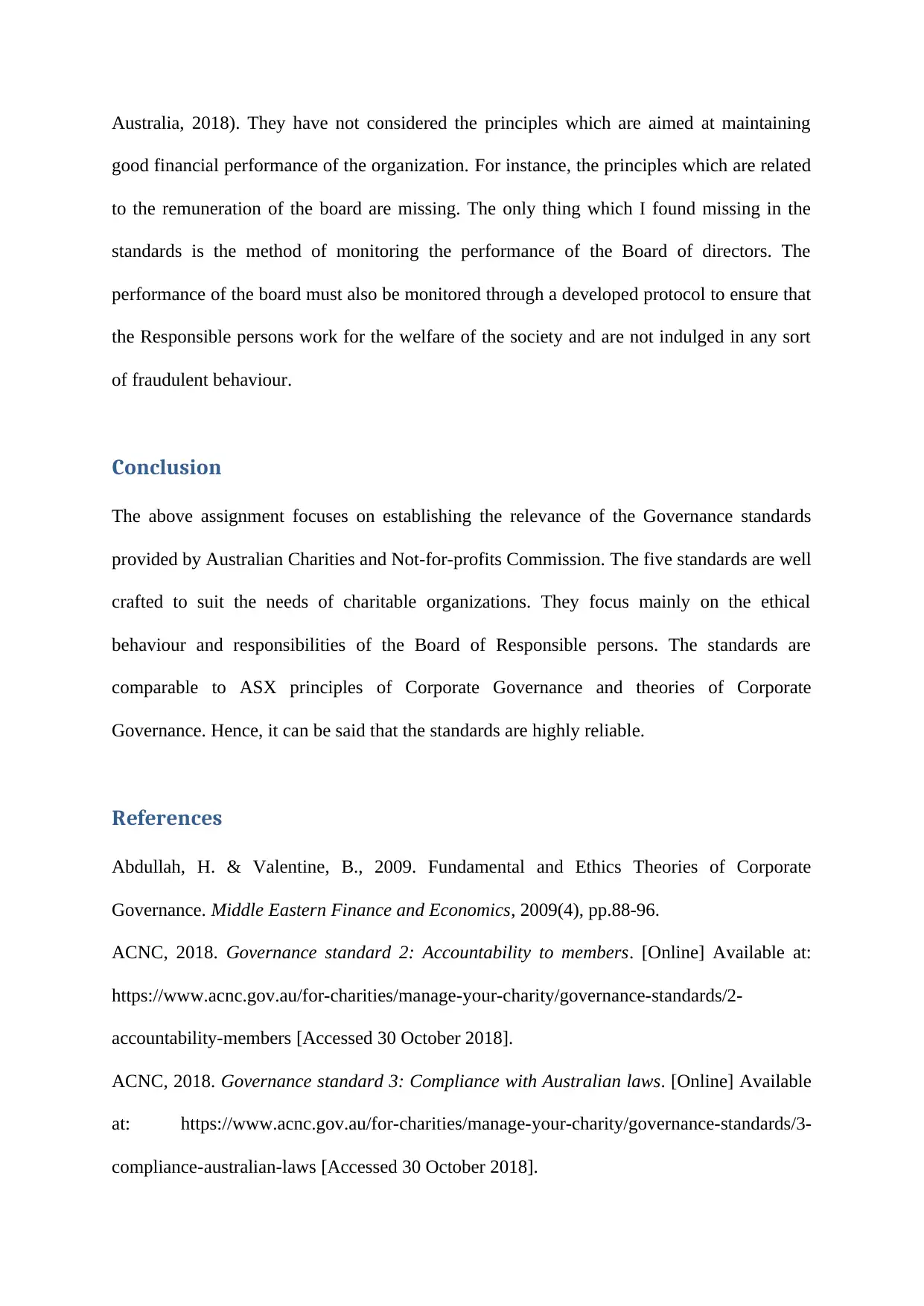
Australia, 2018). They have not considered the principles which are aimed at maintaining
good financial performance of the organization. For instance, the principles which are related
to the remuneration of the board are missing. The only thing which I found missing in the
standards is the method of monitoring the performance of the Board of directors. The
performance of the board must also be monitored through a developed protocol to ensure that
the Responsible persons work for the welfare of the society and are not indulged in any sort
of fraudulent behaviour.
Conclusion
The above assignment focuses on establishing the relevance of the Governance standards
provided by Australian Charities and Not-for-profits Commission. The five standards are well
crafted to suit the needs of charitable organizations. They focus mainly on the ethical
behaviour and responsibilities of the Board of Responsible persons. The standards are
comparable to ASX principles of Corporate Governance and theories of Corporate
Governance. Hence, it can be said that the standards are highly reliable.
References
Abdullah, H. & Valentine, B., 2009. Fundamental and Ethics Theories of Corporate
Governance. Middle Eastern Finance and Economics, 2009(4), pp.88-96.
ACNC, 2018. Governance standard 2: Accountability to members. [Online] Available at:
https://www.acnc.gov.au/for-charities/manage-your-charity/governance-standards/2-
accountability-members [Accessed 30 October 2018].
ACNC, 2018. Governance standard 3: Compliance with Australian laws. [Online] Available
at: https://www.acnc.gov.au/for-charities/manage-your-charity/governance-standards/3-
compliance-australian-laws [Accessed 30 October 2018].
good financial performance of the organization. For instance, the principles which are related
to the remuneration of the board are missing. The only thing which I found missing in the
standards is the method of monitoring the performance of the Board of directors. The
performance of the board must also be monitored through a developed protocol to ensure that
the Responsible persons work for the welfare of the society and are not indulged in any sort
of fraudulent behaviour.
Conclusion
The above assignment focuses on establishing the relevance of the Governance standards
provided by Australian Charities and Not-for-profits Commission. The five standards are well
crafted to suit the needs of charitable organizations. They focus mainly on the ethical
behaviour and responsibilities of the Board of Responsible persons. The standards are
comparable to ASX principles of Corporate Governance and theories of Corporate
Governance. Hence, it can be said that the standards are highly reliable.
References
Abdullah, H. & Valentine, B., 2009. Fundamental and Ethics Theories of Corporate
Governance. Middle Eastern Finance and Economics, 2009(4), pp.88-96.
ACNC, 2018. Governance standard 2: Accountability to members. [Online] Available at:
https://www.acnc.gov.au/for-charities/manage-your-charity/governance-standards/2-
accountability-members [Accessed 30 October 2018].
ACNC, 2018. Governance standard 3: Compliance with Australian laws. [Online] Available
at: https://www.acnc.gov.au/for-charities/manage-your-charity/governance-standards/3-
compliance-australian-laws [Accessed 30 October 2018].
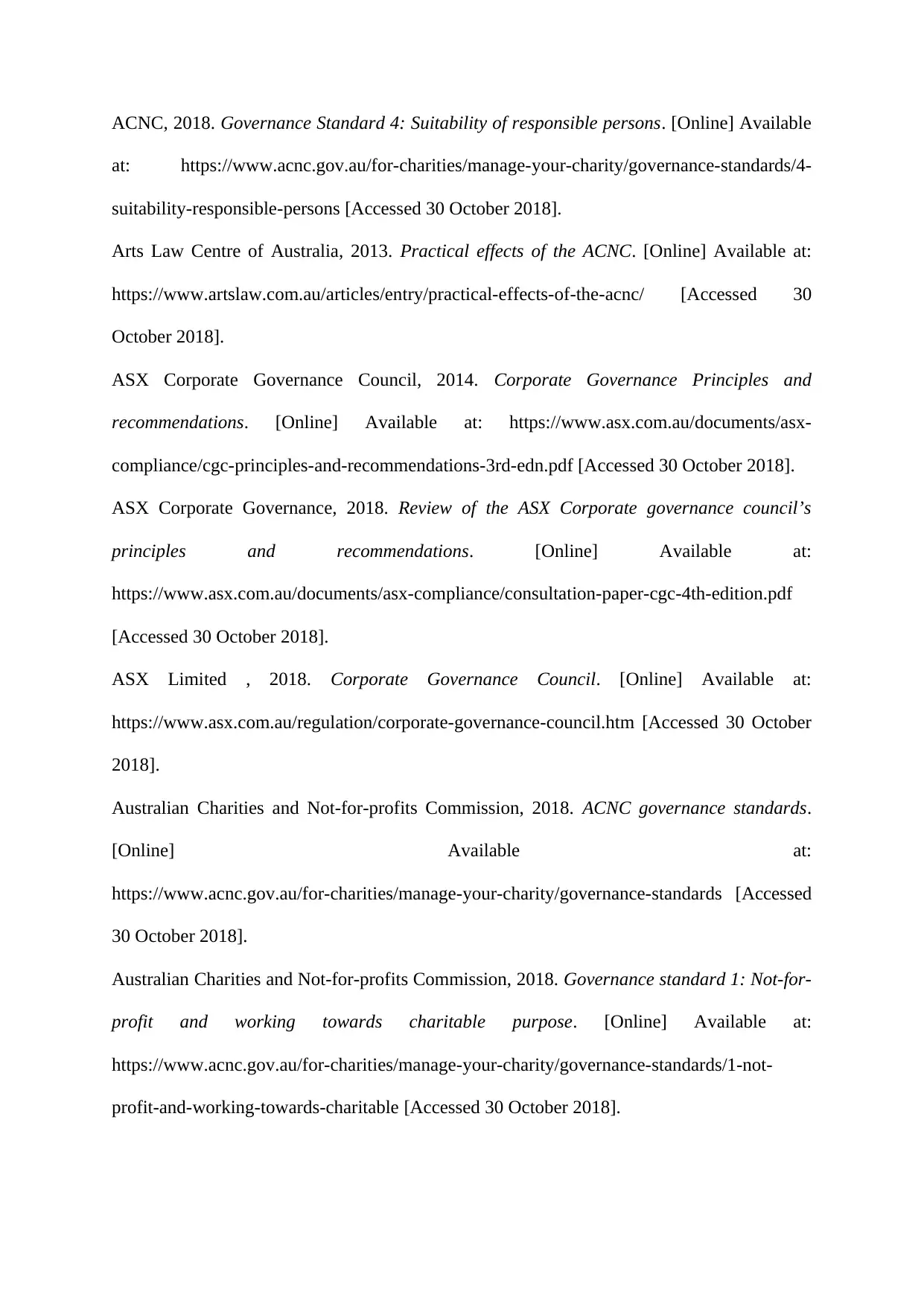
ACNC, 2018. Governance Standard 4: Suitability of responsible persons. [Online] Available
at: https://www.acnc.gov.au/for-charities/manage-your-charity/governance-standards/4-
suitability-responsible-persons [Accessed 30 October 2018].
Arts Law Centre of Australia, 2013. Practical effects of the ACNC. [Online] Available at:
https://www.artslaw.com.au/articles/entry/practical-effects-of-the-acnc/ [Accessed 30
October 2018].
ASX Corporate Governance Council, 2014. Corporate Governance Principles and
recommendations. [Online] Available at: https://www.asx.com.au/documents/asx-
compliance/cgc-principles-and-recommendations-3rd-edn.pdf [Accessed 30 October 2018].
ASX Corporate Governance, 2018. Review of the ASX Corporate governance council’s
principles and recommendations. [Online] Available at:
https://www.asx.com.au/documents/asx-compliance/consultation-paper-cgc-4th-edition.pdf
[Accessed 30 October 2018].
ASX Limited , 2018. Corporate Governance Council. [Online] Available at:
https://www.asx.com.au/regulation/corporate-governance-council.htm [Accessed 30 October
2018].
Australian Charities and Not-for-profits Commission, 2018. ACNC governance standards.
[Online] Available at:
https://www.acnc.gov.au/for-charities/manage-your-charity/governance-standards [Accessed
30 October 2018].
Australian Charities and Not-for-profits Commission, 2018. Governance standard 1: Not-for-
profit and working towards charitable purpose. [Online] Available at:
https://www.acnc.gov.au/for-charities/manage-your-charity/governance-standards/1-not-
profit-and-working-towards-charitable [Accessed 30 October 2018].
at: https://www.acnc.gov.au/for-charities/manage-your-charity/governance-standards/4-
suitability-responsible-persons [Accessed 30 October 2018].
Arts Law Centre of Australia, 2013. Practical effects of the ACNC. [Online] Available at:
https://www.artslaw.com.au/articles/entry/practical-effects-of-the-acnc/ [Accessed 30
October 2018].
ASX Corporate Governance Council, 2014. Corporate Governance Principles and
recommendations. [Online] Available at: https://www.asx.com.au/documents/asx-
compliance/cgc-principles-and-recommendations-3rd-edn.pdf [Accessed 30 October 2018].
ASX Corporate Governance, 2018. Review of the ASX Corporate governance council’s
principles and recommendations. [Online] Available at:
https://www.asx.com.au/documents/asx-compliance/consultation-paper-cgc-4th-edition.pdf
[Accessed 30 October 2018].
ASX Limited , 2018. Corporate Governance Council. [Online] Available at:
https://www.asx.com.au/regulation/corporate-governance-council.htm [Accessed 30 October
2018].
Australian Charities and Not-for-profits Commission, 2018. ACNC governance standards.
[Online] Available at:
https://www.acnc.gov.au/for-charities/manage-your-charity/governance-standards [Accessed
30 October 2018].
Australian Charities and Not-for-profits Commission, 2018. Governance standard 1: Not-for-
profit and working towards charitable purpose. [Online] Available at:
https://www.acnc.gov.au/for-charities/manage-your-charity/governance-standards/1-not-
profit-and-working-towards-charitable [Accessed 30 October 2018].
Paraphrase This Document
Need a fresh take? Get an instant paraphrase of this document with our AI Paraphraser
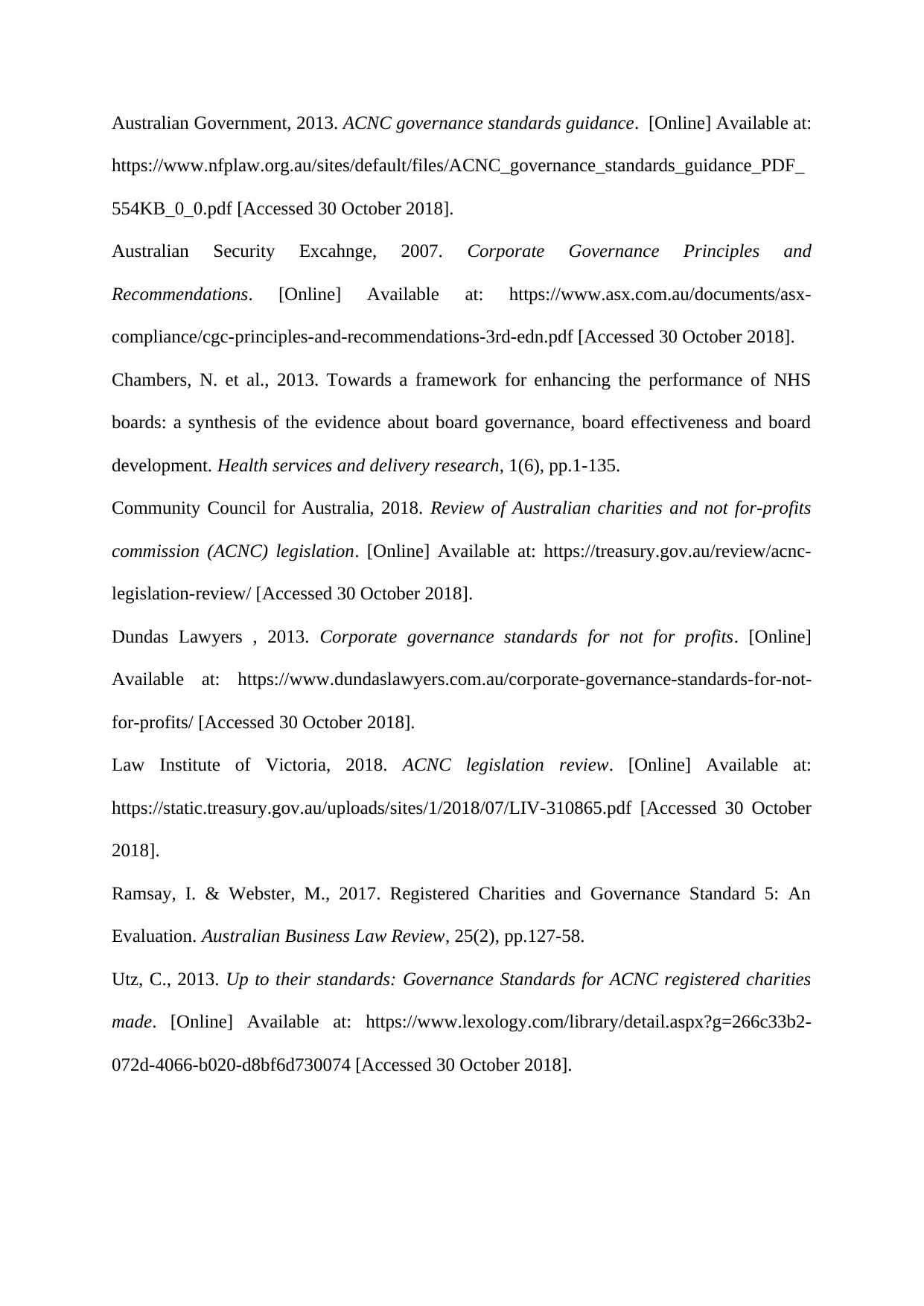
Australian Government, 2013. ACNC governance standards guidance. [Online] Available at:
https://www.nfplaw.org.au/sites/default/files/ACNC_governance_standards_guidance_PDF_
554KB_0_0.pdf [Accessed 30 October 2018].
Australian Security Excahnge, 2007. Corporate Governance Principles and
Recommendations. [Online] Available at: https://www.asx.com.au/documents/asx-
compliance/cgc-principles-and-recommendations-3rd-edn.pdf [Accessed 30 October 2018].
Chambers, N. et al., 2013. Towards a framework for enhancing the performance of NHS
boards: a synthesis of the evidence about board governance, board effectiveness and board
development. Health services and delivery research, 1(6), pp.1-135.
Community Council for Australia, 2018. Review of Australian charities and not for-profits
commission (ACNC) legislation. [Online] Available at: https://treasury.gov.au/review/acnc-
legislation-review/ [Accessed 30 October 2018].
Dundas Lawyers , 2013. Corporate governance standards for not for profits. [Online]
Available at: https://www.dundaslawyers.com.au/corporate-governance-standards-for-not-
for-profits/ [Accessed 30 October 2018].
Law Institute of Victoria, 2018. ACNC legislation review. [Online] Available at:
https://static.treasury.gov.au/uploads/sites/1/2018/07/LIV-310865.pdf [Accessed 30 October
2018].
Ramsay, I. & Webster, M., 2017. Registered Charities and Governance Standard 5: An
Evaluation. Australian Business Law Review, 25(2), pp.127-58.
Utz, C., 2013. Up to their standards: Governance Standards for ACNC registered charities
made. [Online] Available at: https://www.lexology.com/library/detail.aspx?g=266c33b2-
072d-4066-b020-d8bf6d730074 [Accessed 30 October 2018].
https://www.nfplaw.org.au/sites/default/files/ACNC_governance_standards_guidance_PDF_
554KB_0_0.pdf [Accessed 30 October 2018].
Australian Security Excahnge, 2007. Corporate Governance Principles and
Recommendations. [Online] Available at: https://www.asx.com.au/documents/asx-
compliance/cgc-principles-and-recommendations-3rd-edn.pdf [Accessed 30 October 2018].
Chambers, N. et al., 2013. Towards a framework for enhancing the performance of NHS
boards: a synthesis of the evidence about board governance, board effectiveness and board
development. Health services and delivery research, 1(6), pp.1-135.
Community Council for Australia, 2018. Review of Australian charities and not for-profits
commission (ACNC) legislation. [Online] Available at: https://treasury.gov.au/review/acnc-
legislation-review/ [Accessed 30 October 2018].
Dundas Lawyers , 2013. Corporate governance standards for not for profits. [Online]
Available at: https://www.dundaslawyers.com.au/corporate-governance-standards-for-not-
for-profits/ [Accessed 30 October 2018].
Law Institute of Victoria, 2018. ACNC legislation review. [Online] Available at:
https://static.treasury.gov.au/uploads/sites/1/2018/07/LIV-310865.pdf [Accessed 30 October
2018].
Ramsay, I. & Webster, M., 2017. Registered Charities and Governance Standard 5: An
Evaluation. Australian Business Law Review, 25(2), pp.127-58.
Utz, C., 2013. Up to their standards: Governance Standards for ACNC registered charities
made. [Online] Available at: https://www.lexology.com/library/detail.aspx?g=266c33b2-
072d-4066-b020-d8bf6d730074 [Accessed 30 October 2018].
1 out of 14
Your All-in-One AI-Powered Toolkit for Academic Success.
+13062052269
info@desklib.com
Available 24*7 on WhatsApp / Email
![[object Object]](/_next/static/media/star-bottom.7253800d.svg)
Unlock your academic potential
© 2024 | Zucol Services PVT LTD | All rights reserved.

